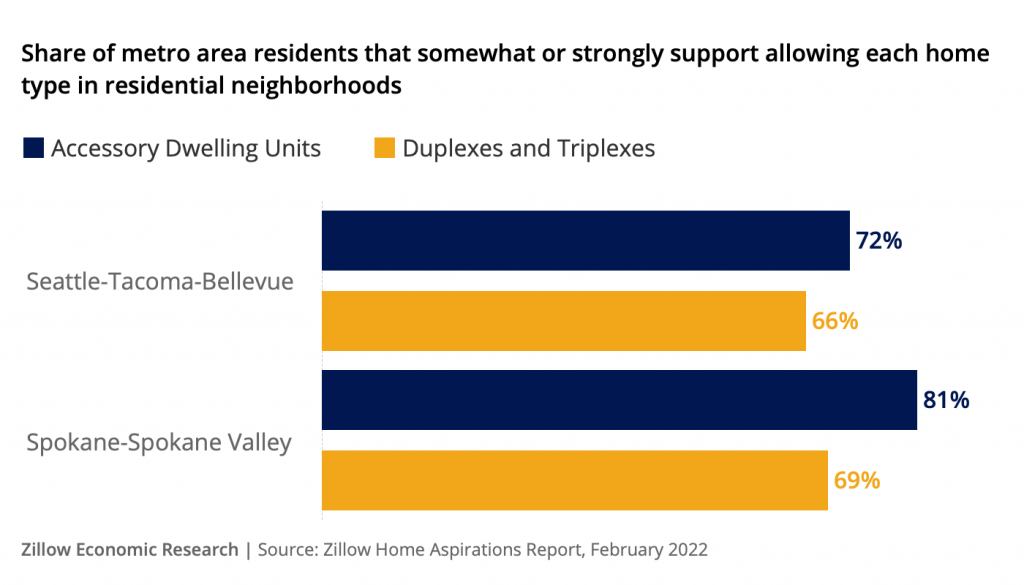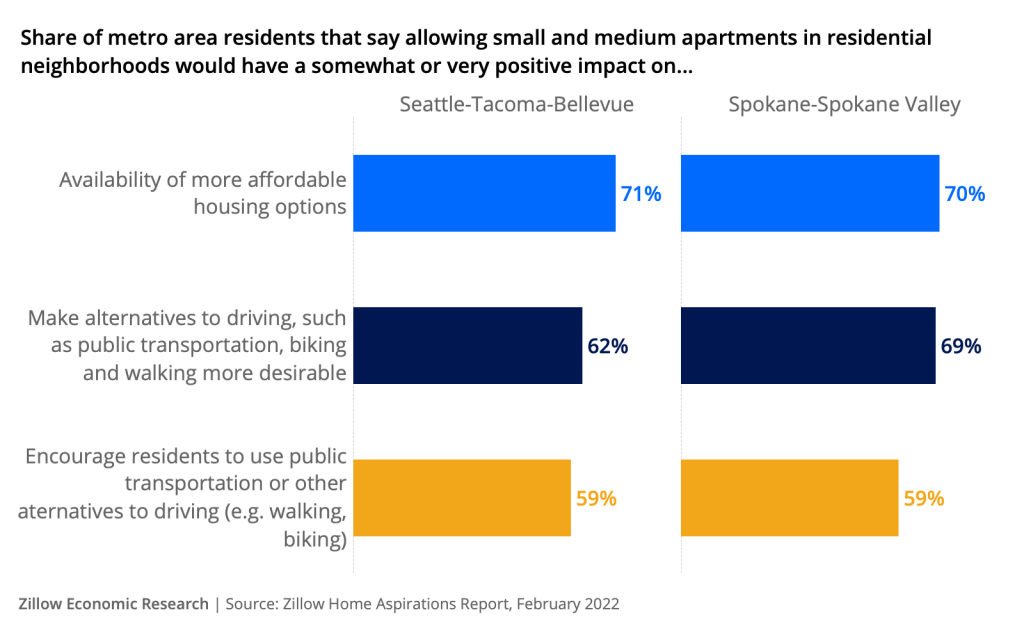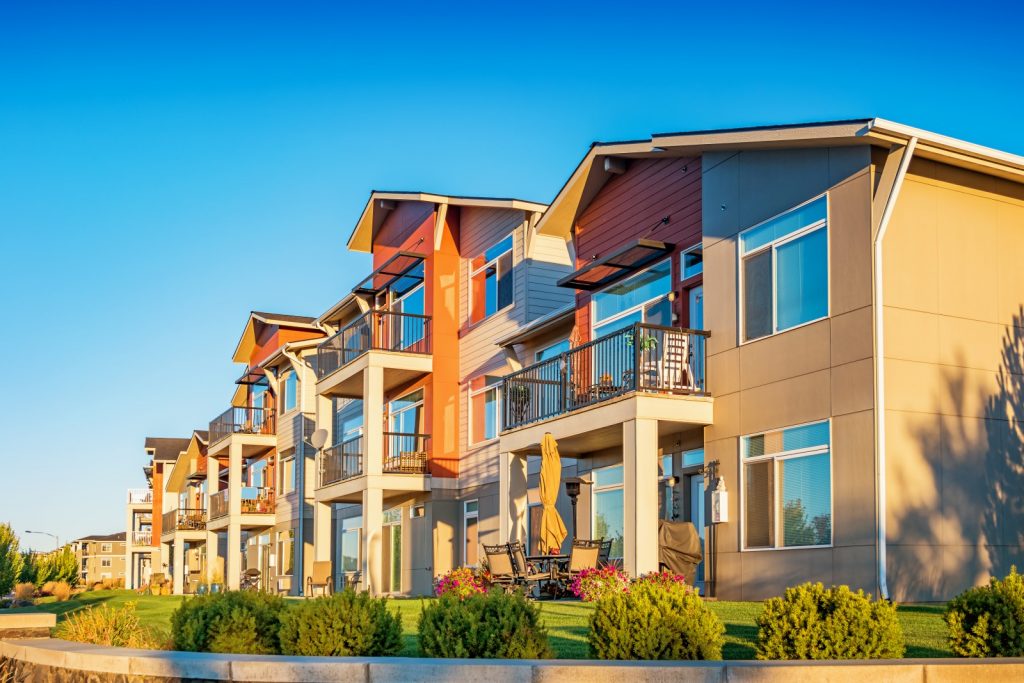Across Seattle and Spokane Metros, Most Residents Support Allowing More Homes, Neighbors
A majority of residents surveyed in Washington’s largest metro and suburban areas are concerned about rising housing costs and support allowing duplexes, triplexes and accessory dwelling units in residential neighborhoods to provide more affordable options
- A majority of residents surveyed in Washington’s largest metro and suburban areas are concerned about rising housing costs and support allowing duplexes, triplexes and accessory dwelling units in residential neighborhoods
- Approximately 71% of respondents agree that allowing small and medium-sized apartments in neighborhoods would create more affordable housing options
In a recent survey conducted by Zillow, a majority of respondents in both the Seattle-Tacoma-Bellevue and Spokane-Spokane Valley metropolitan areas agreed they are worried about the cost of housing in their neighborhoods: 73% of Seattle-area residents said they agreed, as did 74% in the Spokane area.
When it came to solutions to add more housing options in residential neighborhoods, residents of both metros were generally supportive of modest densification measures – to help add new housing in a tight market defined by limited inventory. Residents were most likely to say they supported allowing modest densification measures such as accessory dwelling units (72% in the Seattle area and 81% in the Spokane area),1 followed by duplexes and triplexes (66% and 69%, respectively). When asked if they would support a multi-family residence, such as an apartment building, being built in their neighborhood, closer to half the residents in each metro agreed they would support it: 53% of Seattle-area residents said they agreed, similar to 50% in the Spokane area.2

While a minority of respondents opposed allowing apartment buildings, opponents were more likely to say they felt strongly about their opinions: Of the 38% opposed to new apartment buildings in the Seattle area, 60% said they disagreed strongly with constructing multi-family apartments in their neighborhoods. While 53% of Seattle-area residents said they supported such construction, 46% of supporters reported agreeing strongly with constructing apartments.
Suburban residents of these metro areas did not differ significantly from the metros as a whole. Suburbanites in the Seattle metro, for example, were supportive of allowing modest densification efforts such as duplexes and triplexes (65%) and accessory dwelling units (70%). Similar to the greater Seattle metro, about half (52%) of Seattle-area suburbanites agreed they would support a multi-family residence like an apartment building being built in their neighborhood. Spokane-area suburbanites showed a similar trend: 63% were supportive of allowing duplexes and triplexes; 77% said the same about accessory dwelling units; and 46% agreed they would support an apartment building being built in their neighborhood.
Consistent with previous research, homeowners generally support these modest densification measures as well, but are split on apartments: Most homeowners in these metros support allowing accessory dwelling units (68% in the Seattle area and 80% in the Spokane area), and duplexes and triplexes (62% in the Seattle area and 65% in the Spokane area) in residential neighborhoods. These homeowners, however, split more evenly when asked if they would agree with building an apartment building in their neighborhood (45% in Seattle area and 43% in the Spokane area).3
Most residents agree: modest densification of residential neighborhoods could create more affordable housing and encourage alternative uses of transportation.
While residents were less likely to express support for an apartment building or complex in their neighborhood compared to duplexes, triplexes and accessory dwelling units, they were generally more likely to say allowing small and medium apartments would have a somewhat or very positive impact on affordability (71% in the Seattle area and 70% in the Spokane area) and encouraging residents to use alternatives to driving, such as public transit (59% among both Seattle and Spokane-area residents).

Residents revealed a split when asked about the impact of allowing more home types on the value of existing homes in their neighborhoods: About half (48% in the Seattle area and 47% in the Spokane area) said it would have a very or somewhat positive impact on existing home values.4 Residents in both metros were most likely to say allowing more home types would have a somewhat or very negative impact on parking and traffic (62% of Seattle-area residents and 54% in the Spokane area). However, 60% of Seattle-area residents and 61% of those in the Spokane area agreed that having more affordable housing in their community is more important than free parking for themselves.
Methodology
In order to gain a comprehensive understanding of adults in the Seattle and Spokane, WA metropolitan areas, Zillow Group Population Science conducted a representative survey of more than 850 adults across both metros. The survey was fielded in January and February 2022. This was the first year that ZG Population Science designed, fielded and analyzed the survey entirely in-house.
Sampling & Weighting
Results from this survey are representative of adults in each metropolitan area. To achieve representativeness, ZG Population Science used a two-pronged approach. First, the initial recruitment to the sample was balanced to all adults from the U.S. Census Bureau’s 2019 American Community Survey (ACS) on the basis of age, urbanicity/population density, relationship status, income, ethnicity/race, education and sex. Additional targeted subgroups were sampled based on all key household demographic characteristics. Second, statistical raking was used to create calibration weights to ensure that the distribution of survey respondents matched each metro’s population with respect to a number of key demographic characteristics.
1 Response options were support strongly, support somewhat, oppose strongly, oppose somewhat, and not sure. Among Seattle-area residents, 16% opposed somewhat or strongly, and 12% said they were not sure. Among Spokane-area residents, 13% opposed and 6% were unsure. Strong opposition was uncommon in both metros (8% in the Seattle area and 5% in the Spokane area).
238% of Seattle-area residents said they disagreed somewhat or completely with this statement, and 9% said they were not sure. Among Spokane-area residents, 44% said they disagreed somewhat or completely and 6% said they were unsure.
346% of Seattle-area homeowners said they disagreed somewhat or strongly and 9% were not sure. Among Spokane-area homeowners, 51% disagreed and 6% said they were not sure.
434% of Seattle-area residents said it would have a very or somewhat negative impact on existing home values and 18% said they were not sure. Among Spokane-area residents, 39% said it would have a very/somewhat negative impact and 14% were unsure.


